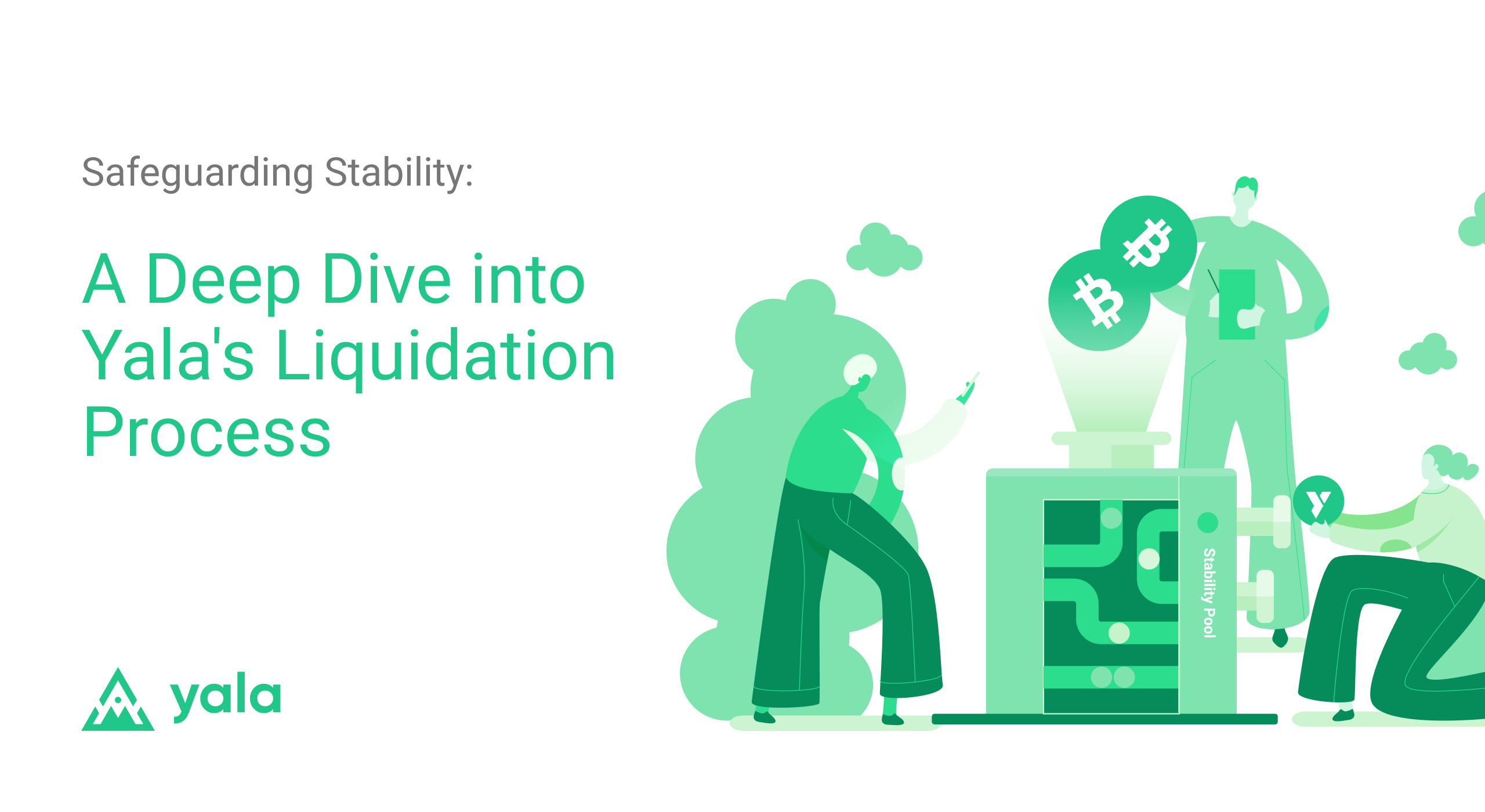Safeguarding Stability: A Deep Dive into Yala's Liquidation Process
Yala's liquidation process empowers users while safeguarding the protocol whilst managing collateral and debt to protect against volatility. Let's explore how Yala’s liquidation mechanism works, the incentives it provides, and the role of the $YALA token in ensuring a resilient ecosystem.

Yala's liquidation process empowers users while safeguarding the protocol. Through components like the Stability Pool and the incentivized participation of liquidators, the system effectively manages collateral and debt to protect against market volatility.
In this blog, we’ll explore how Yala’s liquidation mechanism works, the incentives it provides, and the role of the $YALA token in ensuring a resilient ecosystem. Whether you’re a borrower, Stability Pool contributor, or liquidator, Yala’s process offers a clear, user-focused path to maintaining financial health.
Let’s dive in.
Collateral & Debt Management
At the core of Yala’s system is the ability for users to create vaults, which act as personal smart contracts for collateralized borrowing. By depositing Bitcoin into these vaults, users can mint Yala’s stablecoin, $YU. This process allows Bitcoin holders to unlock the liquidity of their assets without selling them, preserving exposure to Bitcoin’s price movements while accessing DeFi opportunities.
Creating vaults: The Basics
- Collateralization: Users create their own Vault, which acts as a personalized account for managing their collateral and debt. The exact process depends on the operational mode they choose:
- Lite Mode: In this user-friendly mode, Yala’s automated system handles most of the backend processes. Here, YBTC (the tokenized representation of Bitcoin) is automatically generated and deposited into the smart contract on behalf of the user.
- Pro Mode: For advanced users, this mode offers greater control. Users manage the process themselves, directly interacting with the protocol to deposit their YBTC into the smart contract.
- Minting $YU: Once collateral is deposited, users can mint $YU stablecoins up to a specific limit, determined by the Loan-to-Value (LTV) ratio. This ratio ensures that the amount of $YU borrowed does not exceed the value of the collateral beyond safe thresholds.
Minimum Collateral Ratio (MCR): A Safety Net
To maintain the system’s stability, the Yala Foundation sets a Minimum Collateral Ratio (MCR), which defines the minimum required collateral value relative to the debt (minted $YU). For instance:
- If the MCR is set at 150%, it means the value of the collateral must always be at least 1.5 times the value of the minted $YU.
- Falling below this threshold makes the Vault eligible for liquidation, a necessary step to prevent debt and ensure the stability of the system.
Example Scenario: Managing Collateral and Debt
Imagine a user, Alice, who creates a Vault:
- Alice deposits $1,000 worth of Bitcoin as collateral.
- She mints $YU stablecoins worth $666.67, maintaining an Individual Collateral Ratio (ICR) of 150%, meeting the MCR requirement.
Now, let’s say the price of Bitcoin drops:
- The value of Alice’s collateral decreases to $800, lowering her ICR to 120% (800/666.67).
- Since her ICR has fallen below the MCR of 150%, her Vault becomes eligible for liquidation to protect the system.
By adhering to the MCR and monitoring the ICR of each Vault, Yala ensures that the system remains over-collateralized, safeguarding the stability of $YU and the protocol as a whole. This collateral management framework creates a reliable and secure environment for users while minimizing systemic risks.
The Role of the Stability Pool
The Stability Pool is a cornerstone of the Yala protocol, ensuring the system remains stable even during market volatility. It acts as a safeguard, absorbing bad debt from under-collateralized vaults while redistributing collateral to those who support the system.
What is the Stability Pool?
The Stability Pool is a reserve of Yala’s stablecoin, $YU, contributed by users who wish to support the protocol’s stability. This pool is a key mechanism for managing liquidations and maintaining the peg of $YU to the US dollar.
- Depositors' Role: Users deposit their $YU into the Stability Pool, enabling the protocol to utilize these funds during liquidations.
- Incentives for Participation: Stability Pool depositors earn rewards in return for their contributions. These rewards include:
- $YALA Tokens: As incentives for maintaining liquidity.
- Collateral from Liquidated vaults: When a Vault is liquidated, its collateral is distributed to Stability Pool participants based on their share in the pool.
How Does the Stability Pool Work During Liquidations?
When a Vault’s Individual Collateral Ratio (ICR) falls below the Minimum Collateral Ratio (MCR), it becomes eligible for liquidation. The Stability Pool plays a pivotal role in this process:
- Absorbing Debt:
- The debt of the liquidated Vault is repaid using $YU from the Stability Pool. This ensures that the protocol remains solvent and prevents the creation of unbacked $YU.
- Redistributing Collateral:
- In return for covering the debt, the protocol distributes the liquidated Vault’s collateral (Bitcoin) to Stability Pool depositors. This collateral is allocated proportionally based on each depositor’s share of the pool.
How Liquidation Works
Liquidation is a critical mechanism in Yala’s protocol, ensuring the system maintains stability and solvency even when vaults fall below the required collateralization thresholds. This process protects the platform, depositors, and the broader ecosystem by efficiently addressing under-collateralized positions.
Trigger Mechanism
Liquidation is triggered when a Vault’s Individual Collateral Ratio (ICR) falls below the Minimum Collateral Ratio (MCR) set by the Yala Foundation.
- ICR Defined: The ICR is the ratio of a Vault’s collateral value to its outstanding debt. For example, an ICR of 150% means the collateral is worth 1.5x the borrowed $YU.
- MCR Threshold: The MCR is the minimum required ICR to keep a Vault solvent. If a Vault’s ICR drops below this threshold, it becomes eligible for liquidation.
- Keepers’ Role: External actors, known as keepers, monitor the system for under-collateralized vaults. When a Vault’s ICR falls below the MCR, keepers can initiate the liquidation process and are incentivized with rewards for their participation.
Debt and Collateral Flow
When a liquidation is triggered, the following steps occur to handle the liquidated Vault’s debt and collateral:
- Debt Repayment via Stability Pool:
- The liquidated Vault’s debt (denominated in $YU) is fully repaid using funds from the Stability Pool.
- This ensures that the protocol remains solvent and prevents the accumulation of bad debt.
- Collateral Redistribution:
- In exchange for covering the liquidated debt, the corresponding amount of collateral is distributed to Stability Pool depositors in proportion to their share in the pool.
Redistribution Process
If the Stability Pool is insufficient to fully cover a liquidated Vault’s debt, the system implements a redistribution mechanism:
- Remaining Debt and Collateral: Any leftover debt and collateral from the liquidated Vault are proportionally redistributed among active vaults in the system.
- Proportional Allocation: The redistribution ensures that the system-wide solvency is maintained, even if the Stability Pool is depleted.
Surplus Mechanism
After the liquidated Vault’s debt is repaid, any remaining collateral (surplus) is returned to the original Vault owner:
Example: Liquidation Process in Action
Let’s break down a liquidation scenario for clarity:
- Initial Vault Setup:
- Alice deposits $1,000 worth of Bitcoin into her Vault.
- She borrows $666.67 worth of $YU, maintaining an ICR of 150% (above the MCR).
- Market Volatility:
- The price of Bitcoin drops, reducing Alice’s collateral value to $800.
- Her new ICR is $800 ÷ $666.67 = 120%, which is below the MCR threshold of 150%.
- Liquidation Steps:
- Trigger: A keeper identifies Alice’s Vault as under-collateralized and initiates liquidation.
- Debt Repayment: $666.67 of $YU from the Stability Pool is used to repay Alice’s debt.
- Collateral Redistribution: Stability Pool depositors receive $666.67 worth of Bitcoin, distributed proportionally to their pool share.
- Surplus Return: The remaining $133.33 of Bitcoin (surplus) is returned to Alice.
The liquidation process ensures:
- System Solvency: By repaying bad debt, the protocol remains stable and secure.
- Incentivized Participation: Stability Pool depositors and keepers are rewarded for their contributions, encouraging active engagement.
- Fair Redistribution: Any collateral surplus is returned to Vault owners, ensuring transparency and fairness.
Conclusion
Yala’s liquidation process is designed with both systemic stability and user incentives at its core. By combining a well-structured Stability Pool, fair collateral redistribution, and the multi-faceted utility of the $YALA token, the protocol ensures a balanced and robust ecosystem that protects participants and maintains financial security.
Yala’s approach not only safeguards the platform’s long-term stability but also creates opportunities for all participants—whether as depositors, Vault owners, or liquidators—to actively contribute and benefit from the ecosystem.
To stay updated on the progress of our indexer technology, feel free to follow our developments on GitHub.
Keep an eye on Yala as we keep pushing the boundaries of innovation and shaping the DeFi space's future.
Join the Yala Community
Yala is building a liquidity layer to unlock Bitcoin’s untapped yield across DeFi and RWAs. Users can deposit BTC and access seamless liquidity, enabling efficient capital movement and yield opportunities across ecosystems, chains, and protocols.

